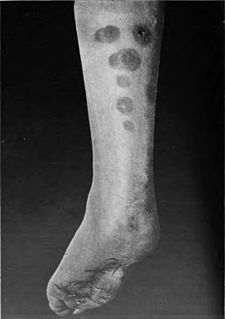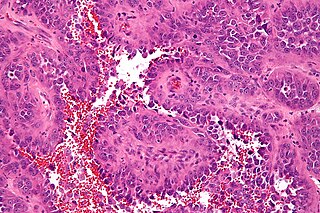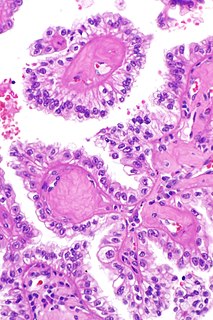Related Research Articles

Squamous-cell skin cancer, also known as cutaneous squamous-cell carcinoma (cSCC), is one of the main types of skin cancer along with basal cell cancer, and melanoma. It usually presents as a hard lump with a scaly top but can also form an ulcer. Onset is often over months. Squamous-cell skin cancer is more likely to spread to distant areas than basal cell cancer. When confined to the outermost layer of the skin, a precancerous or in situ form of cSCC is known as Bowen's disease.

Panniculitis is a group of diseases whose hallmark is inflammation of subcutaneous adipose tissue. Symptoms include tender skin nodules, and systemic signs such as weight loss and fatigue.

Melanoma, also known as malignant melanoma, is a type of skin cancer that develops from the pigment-producing cells known as melanocytes. Melanomas typically occur in the skin but may rarely occur in the mouth, intestines or eye. In women, they most commonly occur on the legs, while in men they most commonly occur on the back. About 25% of melanomas develop from moles. Changes in a mole that can indicate melanoma include an increase in size, irregular edges, change in color, itchiness or skin breakdown.

Angiosarcoma is a cancer of the endothelial cells that line the walls of blood vessels or lymphatic vessels. It primarily affects older adults. Most tumors of visceral blood and lymphatic vessel walls are cancerous (malignant). Because these cancers are carried by the blood flow or lymphatic flow, they can more easily metastasize to distant sites, particularly the liver and lungs. It may occur at any site but most commonly involves skin, soft tissue, breast, and liver.

Mycosis fungoides, also known as Alibert-Bazin syndrome or granuloma fungoides, is the most common form of cutaneous T-cell lymphoma. It generally affects the skin, but may progress internally over time. Symptoms include rash, tumors, skin lesions, and itchy skin.

Cutaneous T cell lymphoma (CTCL) is a class of non-Hodgkin lymphoma, which is a type of cancer of the immune system. Unlike most non-Hodgkin lymphomas, CTCL is caused by a mutation of T cells. The cancerous T cells in the body initially migrate to the skin, causing various lesions to appear. These lesions change shape as the disease progresses, typically beginning as what appears to be a rash which can be very itchy and eventually forming plaques and tumors before spreading to other parts of the body.
Florid cutaneous papillomatosis (FCP), is an obligate paraneoplastic syndrome.
Erythema gyratum repens is a figurate erythema that is rapidly moving and usually a marker of underlying cancer, usually from the lung.
Paraneoplastic acrokeratosis, or Bazex syndrome is a cutaneous condition characterized by psoriasiform changes of hands, feet, ears, and nose, with involvement of the nails and periungual tissues being characteristic and indistinguishable from psoriatic nails. The condition is associated with carcinomas of the upper aerodigestive tract.

A sebaceous adenoma, a type of adenoma, a cutaneous condition characterized by a slow-growing tumor usually presenting as a pink, flesh-coloured, or yellow papule or nodule.

Spiradenoma, also spiroma or eccrine spiradenoma, is a cutaneous condition that is typically characterized, clinically, as a solitary, deep-seated dermal nodule of approximately one centimeter, occurring on the ventral surface of the body. Spiradenoma lesions are benign sudoriferous tumors, and have also been described as cystic epitheliomas of the sweat glands.

Trichoblastomas are a cutaneous condition characterized by benign neoplasms of follicular germinative cells. Trichoblastic fibroma is a designation used to characterize small nodular trichoblastomas with conspicuous fibrocytic stroma, sometimes constituting over 50% of the lesion.
Howel–Evans syndrome is an extremely rare condition involving thickening of the skin in the palms of the hands and the soles of the feet (hyperkeratosis). This familial disease is associated with a high lifetime risk of esophageal cancer. For this reason, it is sometimes known as tylosis with oesophageal cancer (TOC).
Kangri ulcers are a cutaneous condition prevalent among the poorer classes of Kashmir, and a consequence of wearing warm embers. It is unique to this area and may progress to Kangri cancer.
Kairo cancer is a cutaneous condition that may develop due to hydrocarbon-fueled heat exposure from coal-fired clothing warmers.
Kang cancer is a form of squamous-celled carcinoma associated with sleeping on the traditional kang heated-brick bed of Tibet and Northern China. The kang bed is a hollow brick platform warmed by an internal coal, charcoal, or dung fire. Kang cancer often develops in previous burn scar tissue, indicating that smoke carcinogens may not play a role.
Tripe palms, is a cutaneous condition characterized by ridged velvety lesions on the palms resembling the lining of a cow's stomach (tripe).

Reed’s syndrome is a rare inherited condition characterised by multiple cutaneous leiomyomas and, in women, uterine leiomyomas. It predisposes for renal cell cancer, an association denominated hereditary leiomyomatosis and renal cell cancer, and it is also associated with increased risk of uterine leiomyosarcoma. The syndrome is caused by a mutation in the fumarate hydratase gene, which leads to an accumulation of fumarate. The inheritance pattern is autosomal dominant.
Primary cutaneous follicle center lymphoma is a type of lymphoma. It was recognized as a distinct disease entity in the 2008 WHO classification. PCFCL had been previously conceived as a variant of follicular lymphoma (FL).
Cemiplimab, sold under the brand name Libtayo, is a monoclonal antibody medication for the treatment of squamous cell skin cancer. Cemiplimab belongs to a class of drugs that binds to the programmed death receptor-1 (PD-1), blocking the PD-1/PD-L1 pathway.
References
- ↑ Rapini, Ronald P.; Bolognia, Jean L.; Jorizzo, Joseph L. (2007). Dermatology: 2-Volume Set. St. Louis: Mosby. p. 1356. ISBN 978-1-4160-2999-1.